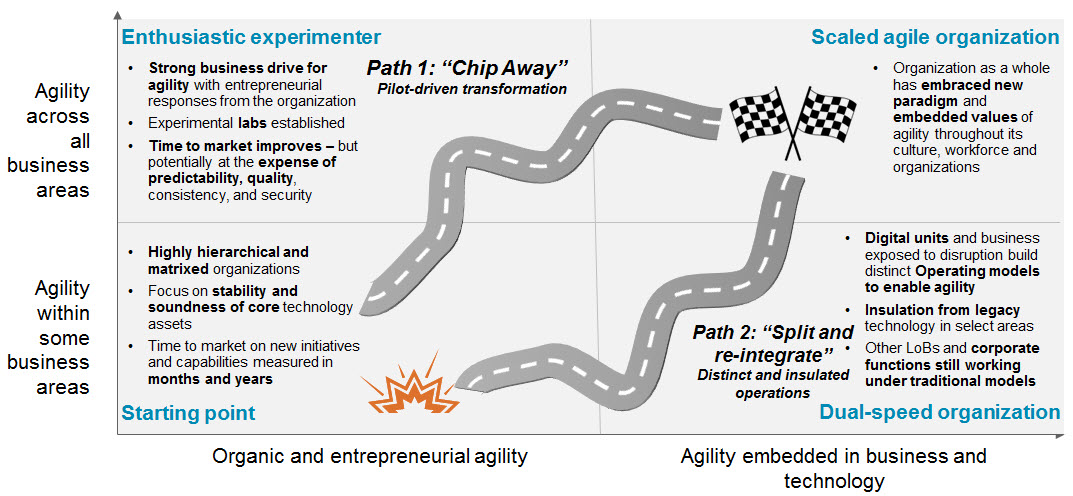Impediments to scaling include change-management challenges, legacy architectures that prevent widespread agile adoption, talent constraints, inflexible silos, and traditional gating mechanisms (especially around funding) that impede continuous development.
Scaling agility means breaking barriers between IT and business units, ideally with increasing levels of co-location by unit, and with fast-forming teams that coalesce for new projects. Agility’s joint business-IT engagement model is faster to market—with little fear of failure. “Minimally awesome” or “minimally viable” products evolve and improve with iteration, based on real-time customer feedback. Agility also requires breaking free of legacy data systems, by building new architecture—cloud, DevOps, test automation, and APIs—that makes it easy to extract structured and unstructured data and run advanced data analytics.
2 Pathways to Agility
The agility journey can take different routes, over a period of two to four years. The two most common pathways are a “chip away” (diverse pilot) approach or a “split and re-integrate” (distinct and insulated) approach—the “enthusiastic experimenter” or “dual-speed” models, respectively (see Figure below).
How would you characterize your position in scaling agility?

The “chip away” approach allows a more methodical build, from a few small pilots to bigger and more widespread pilots, but may stall before scaling. The “split and re-integrate” approach takes strong leadership to create truly distinct operating environments, but presents the challenge of re-integration.
- Chip away. A North American multi-line bank piloted agility with three small teams. After six months, it decided to scale across the organization, training 5,000 people in both IT and business operations over a two-year period. Agility has now penetrated more than 90 percent of the organization, which releases more than 400 products a month. Prior to its agile transformation, product development was an “18 month endeavor” using a waterfall technique.
- Split and re-integrate. A North American media firm separately incubated an agile culture, essentially creating a Tech + Product organization independent from legacy to build its new content distribution platform over two years. It employed agility from inception, including co-location of IT and business teams, which were subsequently integrated into the legacy organization to drive agility into other areas.
Scaling beyond the lab to an enterprise level requires fundamental change across an organization, rather than within a few protected “reserves.” You have two basic choices: change the organization by breaking silos and changing the workforce; or, build new agile clusters or businesses and then meld them with the existing organization. Either way, you can’t avoid the change-management tax. It’s just part of the cost of doing business in the digital age.






